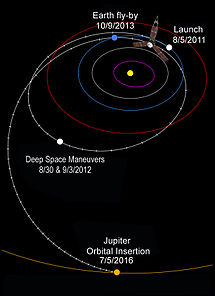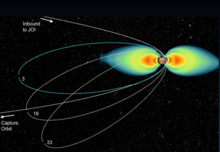uno is a NASA New Frontiers mission currently orbiting the planet Jupiter. Juno was launched from Cape Canaveral Air Force Station on August 5, 2011 and arrived on July 5, 2016.[4][5][6] The spacecraft is in a polar orbit to study Jupiter's composition, gravity field, magnetic field, and polar magnetosphere. Juno will also search for clues about how the planet formed, including whether it has a rocky core, the amount of water present within the deep atmosphere, mass distribution, and its deep winds, which can reach speeds of 618 kilometers per hour (384 mph).[7]
Juno is the second spacecraft to orbit Jupiter, following the Galileo probe which orbited from 1995–2003.
The Juno spacecraft is powered by solar arrays, commonly used by satellites orbiting Earth and working in the inner Solar System, whereas radioisotope thermoelectric generators are commonly used for missions to the outer Solar System and beyond. For Juno, however, three solar array wings, the largest ever deployed on a planetary probe, will play an integral role in stabilizing the spacecraft and generating power.[8]
The spacecraft's name comes from Greco-Roman mythology. The god Jupiter drew a veil of clouds around himself to hide his mischief, but his wife, the goddess Juno, was able to peer through the clouds and see Jupiter's true nature.[9] The mission had previously been referred to by the backronym JUpiter Near-polar Orbiter in a list of NASA acronyms.[10]
Contents
[hide]Overview[edit]
Juno completed a five-year cruise to Jupiter, arriving on July 4, 2016.[5] The spacecraft will travel over a total distance of roughly 2.8 billion kilometers (18.7 AU; 1.74 billion miles).[11] The spacecraft will orbit Jupiter 37 times over the course of 20 months.[4][12] Juno'strajectory used a gravity assist speed boost from Earth, accomplished through an Earth flyby two years (October 2013) after its August 5, 2011 launch.[13] On July 5, 2016, the spacecraft performed an orbit insertion burn to slow it enough to allow capture. It will do two 53-day orbits before performing another burn on October 19 that will bring it into a 14-day polar orbit.
Once in the 14-day orbit, infrared and microwave instruments will begin to measure the thermal radiation emanating from deep withinJupiter's atmosphere. These observations will complement previous studies of its composition by assessing the abundance and distribution of water, and therefore oxygen. This data will provide insight into Jupiter's origins. Juno will also investigate the convectionthat drives general circulation patterns in Jupiter's atmosphere. Other instruments aboard Juno will gather data about its gravitational field and polar magnetosphere. The Juno mission is set to conclude in February 2018, after completing 37 orbits of Jupiter, when the probe will be de-orbited to burn up in Jupiter's outer atmosphere,[4][12] so as to avoid any possibility of impact and biological contamination of one of its moons.[14]
Flight trajectory[edit]
Launch[edit]
Juno was launched atop the Atlas V at Cape Canaveral Air Force Station, Florida. The Atlas V (AV-029) used a Russian-designed and built RD-180 main engine, powered by kerosene and liquid oxygen. At ignition it underwent checkout 3.8 seconds prior to the ignition of five strap-on solid rocket boosters (SRBs). Following SRB burnout, approximately 1 minute 33 seconds into the flight, two of the spent boosters fell away from the vehicle, followed 1.5 seconds later by the remaining three. When heating levels had dropped below predetermined limits, the payload fairing that protected Juno during transit through the thickest part of the atmosphere separated, about 3 minutes 24 seconds into the flight. The Atlas V main engine cut off 4 minutes 26 seconds after liftoff. 16 seconds later, the Centaur second stage ignited and burned for approximately 6 minutes, putting the satellite into an initial parking orbit.[15] The vehicle coasted for approximately 30 minutes, and then the Centaur was re-ignited for a second firing of 9 minutes, placing the spacecraft on an Earth escape trajectory in a heliocentric orbit.
Prior to separation, the Centaur stage used onboard reaction engines to spin Juno up to 1.4 RPM. About 54 minutes after launch, the spacecraft separated from the Centaur and began to extend its solar panels. Following the full deployment and locking of the solar panels, Juno's batteries began to recharge. Deployment of the solar panels reduced Juno's spin rate by two-thirds. The probe is spun to ensure stability during the voyage and so that all instruments on the probe are able to observe Jupiter.[14][16]
The voyage to Jupiter has taken five years, which included an Earth flyby on October 10, 2013.[17][18] On August 12 in 2013, Juno had traveled half of its journey to Jupiter. As it reached the Jovian system, Juno had traveled approximately 19 AU.[19]
Earth flyby[edit]
After traveling for two years in an elliptical heliocentric orbit, Juno returned to pass by Earth in October 2013. It used Earth's gravity to help propel itself toward the Jovian system in a maneuver called a gravitational slingshot.[20] The spacecraft received a boost in speed of more than 8,800 mph (3.9 km/s) and was set on a course to Jupiter.[20][21][22] The flyby was also used as a rehearsal for the Juno science team to test some instruments and practice certain procedures before the arrival to Jupiter.[20][23]
Insertion into Jupiter's orbit[edit]
Jupiter's gravity accelerated the approaching spacecraft to ca. 266,000 km/h (74 km/s) as it approached the planet. On July 5, 2016 between 03:18 and 03:53 UTC earth received time, an insertion burn lasting 2,102 seconds decelerated Juno by 542 m/s[dubious ] and changed its trajectory from a hyperbolic flyby to a closed, elliptical, polar Jovian orbit with a period of about 53.5 days.[24] The orbital period will be decreased to about 14 days over the course of a few months.[25]
Orbit and environment[edit]
Juno's highly elliptical polar orbit takes it close to the planet—within 4,300 kilometers (2,672 mi)—but then far beyond even Callisto's orbit.[26] Each of the lower science-gathering orbits takes 14 days and the spacecraft is expected to complete 37 orbits until the end of the mission.
This type of orbit helps the spacecraft avoid any long-term contact with Jupiter's radiation belts, which can cause damage to spacecraft electronics and solar panels.[26][27] The "Juno Radiation Vault", with 1-centimeter-thick titanium walls, will also aid in protecting and shielding Juno's electronics.[28] Despite the intense radiation, JunoCam and Jovian Infrared Auroral Mapper (JIRAM) are expected to endure at least eight orbits, while the microwave radiometer should endure at least eleven orbits.[25] In comparison, Juno will receive much lower levels of radiation than theGalileo orbiter at its equatorial orbit.
Team[edit]
Scott Bolton of the Southwest Research Institute in San Antonio, Texas is the principal investigator and is responsible for all aspects of the mission. The Jet Propulsion Laboratory in California manages the mission and the Lockheed Martin Corporation was responsible for the spacecraft development and construction. The mission is being carried out with the participation of several institutional partners. Co-investigators include Toby Owen of the University of Hawaii, Andrew Ingersoll of California Institute of Technology, Frances Bagenal of the University of Colorado at Boulder, and Candy Hansen of the Planetary Science Institute. Jack Connerney of the Goddard Space Flight Center served as instrument lead.[29][30]
Cost[edit]
Juno was originally proposed at a cost of approximately US$700 million (FY03) for a June 2009 launch. NASA budgetary restrictions resulted in postponement until August 2011, and a launch on board an Atlas V rocket in the551 configuration. As of June 2011, the mission was projected to cost $1.1 billion over its life.[31][dated info]
Scientific objectives[edit]
The Juno spacecraft's suite of science instruments will:[33]
- Determine the ratio of oxygen to hydrogen, effectively measuring the abundance of water in Jupiter, which will help distinguish among prevailing theories linking Jupiter's formation to the Solar System.
- Obtain a better estimate of Jupiter's core mass, which will also help distinguish among prevailing theories linking Jupiter's formation to the Solar System.
- Precisely map Jupiter's gravitational field to assess the distribution of mass in Jupiter's interior, including properties of its structure and dynamics.
- Precisely map Jupiter's magnetic field to assess the origin and structure of the field and how deep in Jupiter the magnetic field is created. This experiment will also help scientists understand the fundamental physics of dynamo theory.
- Map the variation in atmospheric composition, temperature, structure, cloud opacity and dynamics to pressures far greater than 100 bars (10 MPa; 1450 pound/sq inch) at all latitudes.
- Characterize and explore the three-dimensional structure of Jupiter's polar magnetosphere and its auroras.[34]
- Measure the orbital frame-dragging, known also as Lense–Thirring precession caused by the angular momentum of Jupiter,[35][36] and possibly a new test of general relativity effects connected with the Jovian rotation.[37]
Scientific instruments[edit]
The Juno mission's science objectives will be achieved with a payload of nine instruments on board the spacecraft:[38][39][40][41][42]
| Illustration | Instrument Name | Abbr. | Description and scientific objective |
|---|---|---|---|
| The microwave radiometer comprises six antennas mounted on two of the sides of the body of the probe. They will perform measurements of electromagnetic waves on frequencies in the microwave range: 600 MHz, 1.2 GHz, 2.4 GHz, 4.8 GHz, 9.6 GHz and 22 GHz, the only microwave frequencies which are able to pass through the thick Jovian atmosphere. The radiometer will measure the abundance of water and ammonia in the deep layers of the atmosphere up to 200 bar pressure or 500 to 600 km deep. The combination of different wavelengths and the emission angle should make it possible to obtain a temperature profile at various levels of the atmosphere. The data collected will determine how deep is the atmospheric circulation.[43][44] (Principal investigator: Mike Janssen, Jet Propulsion Laboratory) | |||
| The spectrometer mapper JIRAM, operating in the near infrared (between 2 and 5 μm), conducts surveys in the upper layers of the atmosphere to a depth of between 50 and 70 km where the pressure reaches 5 to 7 bars. JIRAM will provide images of the aurora in the wavelength of 3.4 μm in regions with abundant H3+ ions. By measuring the heat radiated by the atmosphere of Jupiter, JIRAM can determine how clouds with water are flowing beneath the surface. It can also detect methane, water vapor, ammonia andphosphine. It was not required that this device meets the radiation resistance requirements.[45][46][47] (Principal investigator: Angioletta Coradini, Italian National Institute for Astrophysics) | |||
| The magnetic field investigation has three goals: mapping of the magnetic field, determining the dynamics of Jupiter's interior, and determination of the three-dimensional structure of the polar magnetosphere. The magnetometer experiment consists of the Flux Gate Magnetometer (FGM), which will measure the strength and direction of the magnetic field lines, and the Advanced Stellar Compass (ASC), which will monitor the orientation of the magnetometer sensors. (Principal investigator: Jack Connerney, NASA'sGoddard Space Flight Center) | |||
| The purpose of measuring gravity by radio waves is to establish a map of the distribution of mass inside Jupiter. The uneven distribution of mass in Jupiter induces small variations in gravity all along the orbit followed by the probe when it runs closer to the surface of the planet. These gravity variations drive small probe velocity changes. The purpose of radio science is to detect the Doppler effect on radio broadcasts issued by Juno toward Earth in Ka band and X band, which are frequency ranges that can conduct the study with fewer disruptions related to the solar wind or the ionosphere.[48][49][50] (Principal investigator: John AndersonJet Propulsion Laboratory. Principal investigator (Juno's Ka-band Translator KaT): Luciano Iess, Sapienza University of Rome) | |||
| The energetic particle detector JADE will measure the angular distribution, energy, and the velocity vector of ions and electrons at low energy (ions between 13 eV and 20 KeV, electrons of 200 eV to 40 KeV) present in the aurora of Jupiter. On JADE, like JEDI, the electron analyzers are installed on three sides of the upper plate which allows a measure of frequency three times higher.[51][52] (Principal investigator: David McComas, Southwest Research Institute) | |||
| The energetic particle detector JEDI will measure the angular distribution and the velocity vector of ions and electrons at high energy (ions between 20 keV and 1000 keV, electrons from 40 keV to 500 keV) present in the polar magnetosphere of Jupiter. JEDI has three identical sensors dedicated to the study of particular ions of hydrogen,helium, oxygen and sulfur.[52][53] (Principal investigator: Barry Mauk, Applied Physics Laboratory) | |||
| This instrument will identify the regions of auroral currents that define Jovian radio emissions and acceleration of the auroral particles by measuring the radio and plasma spectra in the auroral region.(Principal investigator: William Kurth, University of Iowa) | |||
| UVS will record the wavelength, position and arrival time of detected ultraviolet photons during the time when the spectrograph slit views Jupiter during each turn of the spacecraft. Using a 1024 × 256 micro channel plate detector, it will provide spectral images of the UV auroral emissions in the polar magnetosphere. (Principal investigator: G. Randall Gladstone, Southwest Research Institute) | |||
| A visible light camera/telescope, included in the payload to facilitate education and public outreach. It will operate for only seven orbits around Jupiter because of the planet's damaging radiation and magnetic field. (Principal investigator: Michael C. Malin, Malin Space Science Systems) |
Operational components[edit]
Solar panels[edit]
Juno is the first mission to Jupiter to use solar panels instead of the radioisotope thermoelectric generators (RTG) used by Pioneer 10, Pioneer 11, the Voyager program, Ulysses,Cassini–Huygens, New Horizons, and the Galileo orbiter. It is also the farthest solar-powered trip in the history of space exploration.[54] Once in orbit around Jupiter, Juno will receive 4% as much sunlight as it would on Earth, but the global shortage of Pu-238,[55][56][57][58] as well as advances made in solar cell technology over the past several decades, makes it economically preferable to use solar panels of practical size to provide power at a distance of 5 AU from the Sun.
The Juno spacecraft uses three solar panels symmetrically arranged around the spacecraft. Shortly after it cleared Earth's atmosphere the panels were deployed. Two of the panels have four hinged segments each, and the third panel has three segments and a magnetometer. Each panel is 2.7 meters (8.9 ft) by 8.9 meters (29 ft) long,[59] the biggest on any NASA deep-space probe.[60]
The combined mass of the three panels is nearly 340 kg (750 lb).[61] If the panels were optimized to operate at Earth, they would produce 12 to 14 kilowatts of power. Only about 486 W will be generated when Juno arrives at Jupiter, declining to near 420 W as radiation degrades the cells.[62] The solar panels will remain in sunlight continuously from launch through the end of the mission, except for short periods during the operation of the main engine. A central power distribution and drive unit monitors the power that is generated by the solar panels, distributes it to instruments, heaters and experiment sensors as well as batteries that are charged when excess power is available. Two 55-amp-hour lithium-ionbatteries that are able to withstand the radiation environment of Jupiter will provide power when Juno passes through eclipse.[2]
Telecommunications[edit]
Juno supports tone-fault signalling for cruise-mode operations, but it is expected to be used less often. Communications are via the 70-meter antennae of the Deep Space Network (DSN) utilizing an X-band direct link.[2] The command and data processing of the Juno spacecraft includes a flight computer capable of providing ~50 Mbit/s of instrument throughput. Gravity science subsystems use the X-band and Ka-band doppler tracking and autoranging.
Propulsion[edit]
Juno uses a bipropellant LEROS 1b main engine, manufactured by Moog Inc in Westcott in Buckinghamshire in England.[63] It uses hydrazine and nitrogen tetroxide for propulsion and provides a thrust of 645 newtons. The engine bell is enclosed in a debris shield fixed to the spacecraft body, and is used for major burns. For control of the vehicle's orientation (attitude control) and to perform trajectory correction maneuvers, Juno utilizes amonopropellant reaction control system (RCS) consisting of twelve small thrusters that are mounted on four engine modules.[2]
Galileo's plaque and Lego minifigures[edit]
Juno carries a plaque to Jupiter dedicated to Galileo Galilei. The plaque was provided by the Italian Space Agency and measures 7.1 by 5.1 centimeters (2.8 by 2.0 in). It is made of flight-grade aluminum and weighs 6 grams (0.21 oz).[64] The plaque depicts a portrait of Galileo and a text in Galileo's own hand, penned in January 1610, while observing what would later be known to be the Galilean moons.[64] The text translates as:
The spacecraft also carries three Lego minifigures representing Galileo, the Roman god Jupiter and his wife Juno. In Roman mythology, Jupiter drew a veil of clouds around himself to hide his mischief. From Mount Olympus, Juno was able to look into the clouds and reveal her husband's real nature. Juno holds a magnifying glass as a sign for searching for the truth and her husband holds a lightning bolt. The third Lego crew member, Galileo Galilei, has his telescope with him on the journey.[65] Although most Lego toys are made of plastic, Lego made these Minifigures of aluminum to endure the extreme conditions of space flight.[66]
Timeline[edit]
| Date | Event | Status |
|---|---|---|
| August 2011 | Launched | Completed |
| August 2012 | Trajectory corrections[67] | Completed |
| September 2012 | ||
| October 2013 | Earth flyby for speed boost (from 78,000 miles per hour (126,000 km/h) to 93,000 miles per hour (150,000 km/h))[68] | Completed |
| July 4, 2016 | Arrival at Jupiter & polar orbit insertion (1st orbit)[4][12] | Completed |
| Science phase: 37 orbits planned over 24 months | ||
| February 2018 | Spacecraft disposal in the form of a controlled deorbit into Jupiter[4][12] |




















No comments:
Post a Comment